TRIN Indicator – Technical Analysis
It is a technical analysis instrument that aids traders and investors in gauging market sentiment and spotting probable market-turning moments.
What is the Trading Index (TRIN) Indicator?
Short-Term Trading Index (TRIN), commonly known as the Arms Index is a technical analysis instrument that aids traders and investors in gauging market sentiment and spotting probable market-turning moments.

Richard Arms created it, and market players frequently use it to learn more about the equilibrium between the pressures of buying and selling.
The TRIN Indicator is a valuable tool in technical analysis that helps traders and investors assess market sentiment and identify potential market reversals.
By analyzing the relationship between advancing and declining stocks and their corresponding volumes, the TRIN provides insights into the buying and selling pressure in the market.
Using the TRIN Indicator in conjunction with other technical analysis tools and indicators is important to make well-informed trading decisions.
For the calculation of the TRIN Indicator, the indicator is calculated by dividing the advancing issues by the declining issues ratio by the advancing volume by the declining volume ratio.

The formula for calculating TRIN is the ratio of the number of advancing stocks to declining stocks divided by the ratio of the volume of advancing stocks to declining stocks.
Using TRIN in conjunction with other technical analysis tools can enhance decision-making in trading. It provides insights into the balance of buying and selling pressures in the market, helping identify potential market reversals. The formula for TRIN is as follows:
TRIN = (Number of advancing stocks / Number of declining stocks) / (Volume of advancing stocks / Volume of declining stocks)
Key Takeaways
- The TRIN Indicator, also known as the Arms Index, helps gauge market sentiment and identify potential market reversals by analyzing the relationship between advancing and declining stocks and their corresponding volumes.
- TRIN is calculated by dividing the advancing issues by the declining issues ratio by the advancing volume by the declining volume ratio.
- TRIN values below 1 suggest bullish sentiment, indicating more volume in advancing stocks compared to declining stocks. TRIN values above 1 suggest bearish sentiment, indicating more volume in declining stocks.
- TRIN values close to 1 suggest a balanced market or a lack of significant buying or selling pressure.
- Low TRIN values indicate strong buying pressure and a positive market trend. High
- TRIN values indicate increased selling pressure and a negative market trend. Neutral TRIN values suggest market indecision or a sideways market.
- The TRIN Indicator can be used to identify overbought and oversold conditions, confirm market reversals, analyze market breadth, and time market entries and exits.
Advantages Of Using TRIN Indicator
The TRIN (Trading Index) indicator offers specific advantages over other market sentiment indicators due to its ability to incorporate both price and volume data, providing a holistic view of market sentiment.
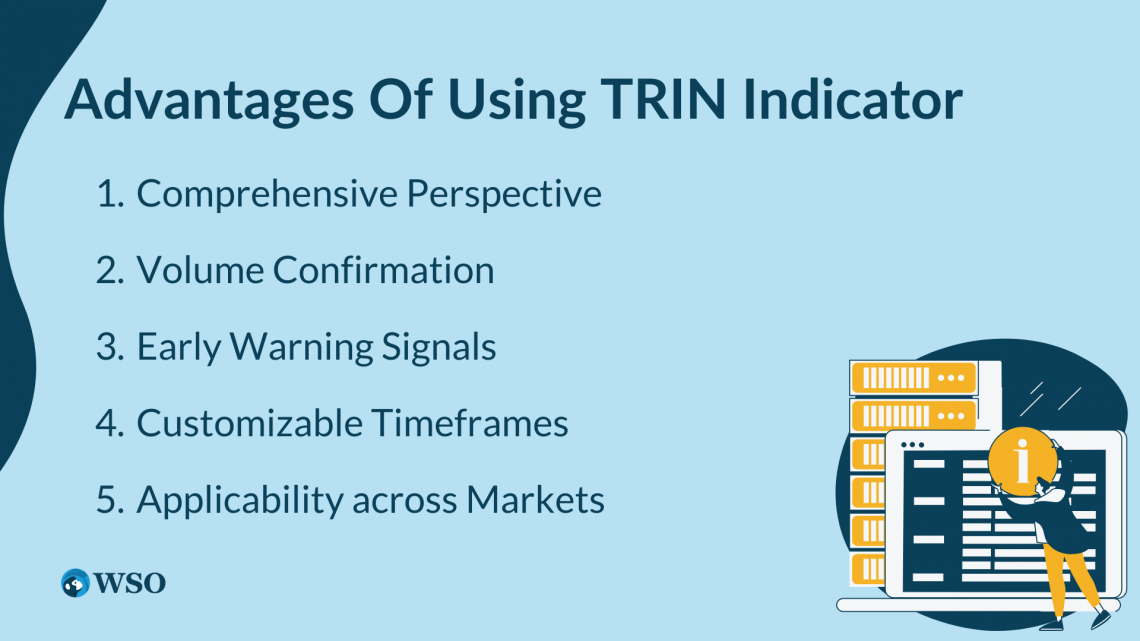
Here are the key advantages in brief:
1. Comprehensive Perspective
Unlike many other market sentiment indicators focusing solely on price or volume, it combines both components. This integration allows for a more comprehensive understanding of market dynamics and sentiment.
2. Volume Confirmation
The TRIN indicator incorporates volume data, adding an important confirmation layer. By comparing advancing and declining volume with advancing and declining issues it provides insights into the strength and conviction behind price movements.
3. Early Warning Signals
It can serve as an early warning signal for potential trend reversals or shifts in market sentiment.
Note
Divergences between the TRIN indicator and price movement can indicate an upcoming reversal or change in sentiment.
4. Customizable Timeframes
The TRIN indicator can be applied to different timeframes, accommodating various trading styles and preferences.
5. Applicability across Markets
It is not limited to specific markets and can be used across a range of asset classes, including stocks, indices, commodities, and currencies.
Breakdown Of TRIN Values
The TRIN Indicator provides valuable insights into market sentiment by measuring the relationship between advancing and declining stocks and their corresponding trading volumes. Traders interpret TRIN values based on different ranges to assess market conditions.

Here's a breakdown of what low, high, and neutral TRIN values suggest about market sentiment:
1. Low TRIN Values (Below 1)
A TRIN value below 1 indicates a market with more volume in advancing stocks compared to declining stocks. This suggests a bullish sentiment and potential buying pressure in the market.
The following implications can be derived from low TRIN values:
- Strong Buying Pressure: A low TRIN value signifies a higher demand for stocks and suggests that buyers are more active than sellers. It indicates optimism and indicates a positive sentiment among market participants.
- Positive Market Trend: Low TRIN values often align with a bullish market trend, indicating a higher probability of upward price movement.
Note
Traders can interpret low TRIN values as a signal to look for buying opportunities or to stay invested in long positions.
2. High TRIN Values (Above 1)
A TRIN value above 1 indicates a market with more volume in declining stocks compared to advancing stocks. This suggests a bearish sentiment and potential selling pressure in the market. The following implications can be derived from high TRIN values:
- Increased Selling Pressure: A high TRIN value suggests that selling pressure dominates the market, with more participants opting to sell their positions.
Note
It indicates pessimism and reflects a negative sentiment among market participants.
- Negative Market Trend: High TRIN values often align with a bearish market trend, indicating a higher probability of downward price movement.
3. Neutral TRIN Values (Close to 1)
A TRIN value close to 1 suggests a balanced market or a lack of significant buying or selling pressure. The implications of neutral TRIN values are as follows:
- Market Indecision: When the TRIN value hovers around 1, it indicates a lack of clear dominance between buyers and sellers. It suggests market participants are relatively balanced in their sentiment and trading activity.
- Sideways Market or Consolidation: Neutral TRIN values are often observed during market consolidation periods or when the market is in a sideways trend.
Note
TRIN values should not be considered in isolation. Traders and investors should analyze other indicators, perform technical analysis, and consider fundamental factors to confirm the market sentiment and make informed trading decisions.
Using The TRIN
Traders and investors use the ARM Index Indicator in various ways to guide their trading decisions. Some common uses include:
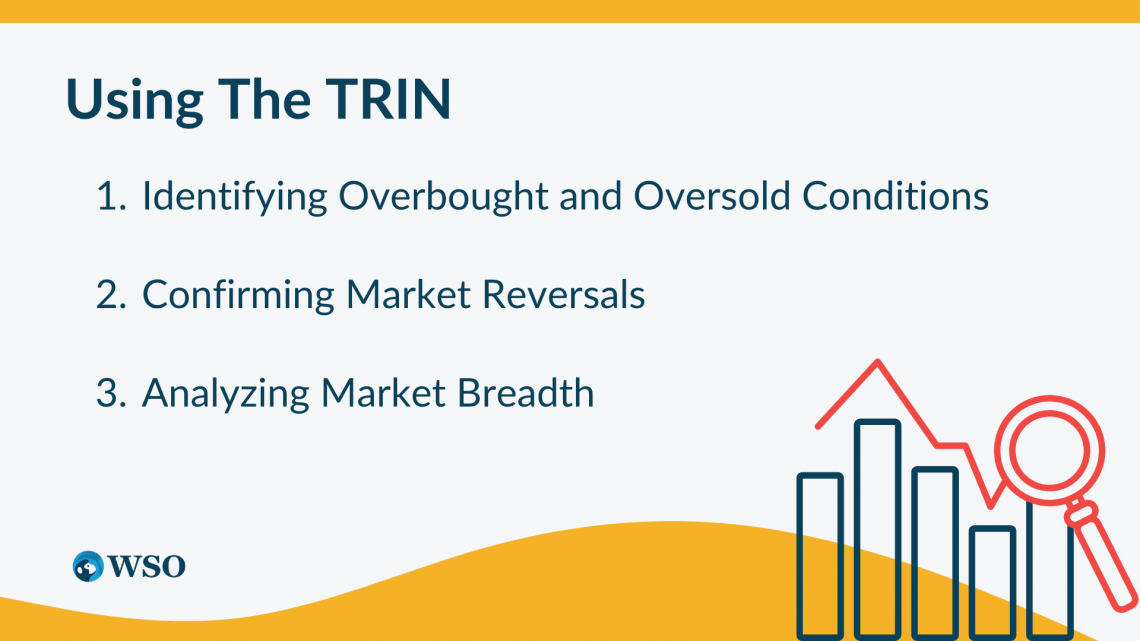
1. Identifying Overbought and Oversold Conditions
Extreme TRIN readings can signal overbought or oversold conditions in the market. A TRIN value below 0.5 may indicate an overbought market, suggesting a potential reversal or correction.
Conversely, a TRIN value above 2 may suggest an oversold market, hinting at a potential bounce or rally.
2. Confirming Market Reversals
Traders look for divergences between the TRIN Indicator and price movements to confirm potential market reversals.
For example, if the market is making new highs while the TRIN shows a bearish divergence (higher TRIN values), it could be a warning sign of a possible trend reversal.
Note
According to several variables, including economic data, geopolitical developments, earnings reports, and investor behavior, market mood can fluctuate between optimistic (positive) and bearish (negative).
3. Analyzing Market Breadth
The TRIN Indicator is also useful for assessing market breadth. By analyzing the TRIN values for specific sectors or industries, traders can gain insights into the relative strength or
weaknesses of those sectors compared to the overall market.
Limitations Of TRIN Indicator
While the TRIN (Trading Index) indicator is a valuable tool for assessing market sentiment, it is important to recognize its limitations. Several factors can affect the reliability of TRIN readings, including:
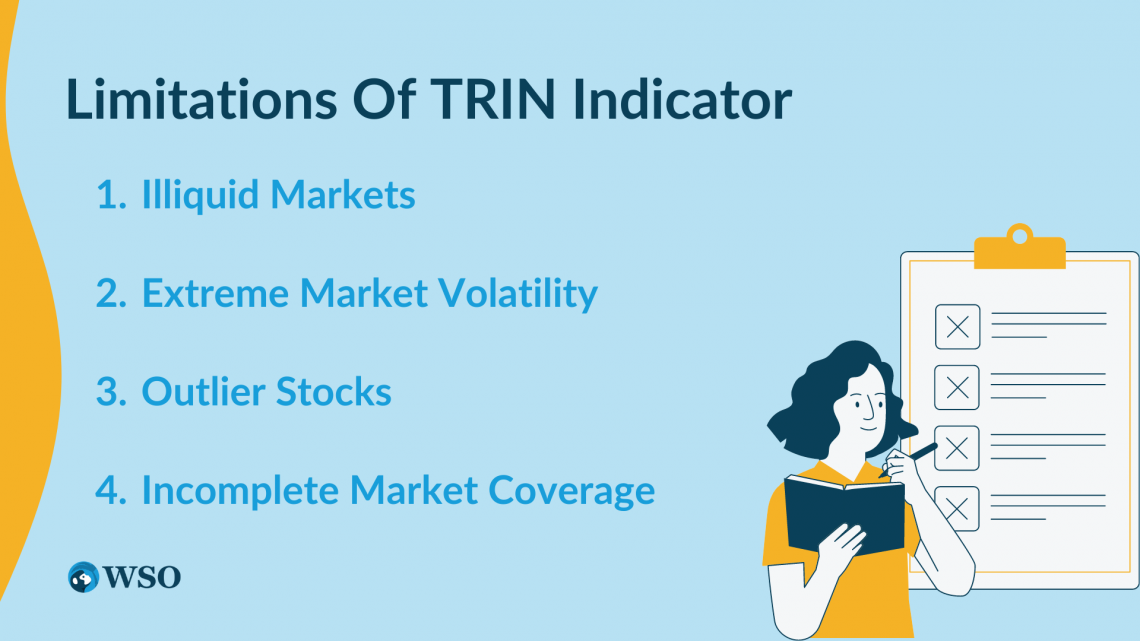
1. Illiquid Markets
The TRIN indicator may not accurately reflect market sentiment in illiquid markets with low trading volumes. Limited participation and fewer transactions can result in skewed readings and less reliable signals.
2. Extreme Market Volatility
During periods of extreme market volatility, such as sharp price swings or market-wide disruptions, the TRIN indicator's reliability may be compromised.
Unusual and rapid market movements can distort the normal relationships between price and volume, leading to misleading TRIN readings.
3. Outlier Stocks
The presence of outlier stocks, which experience significant price or volume fluctuations independent of broader market conditions, can impact TRIN readings.
Note
Outliers can distort the overall market sentiment captured by the TRIN indicator, potentially leading to inaccurate signals.
4. Incomplete Market Coverage
The TRIN indicator's effectiveness depends on the breadth and depth of the market coverage. If the indicator is based on a limited sample of stocks or excludes certain sectors or asset classes, it may not provide a comprehensive representation of overall market sentiment.
Importance Of Market Sentiment
Market sentiment is the collective psychological and emotional perspective held by market players regarding a certain asset, market, or the general state of the economy.
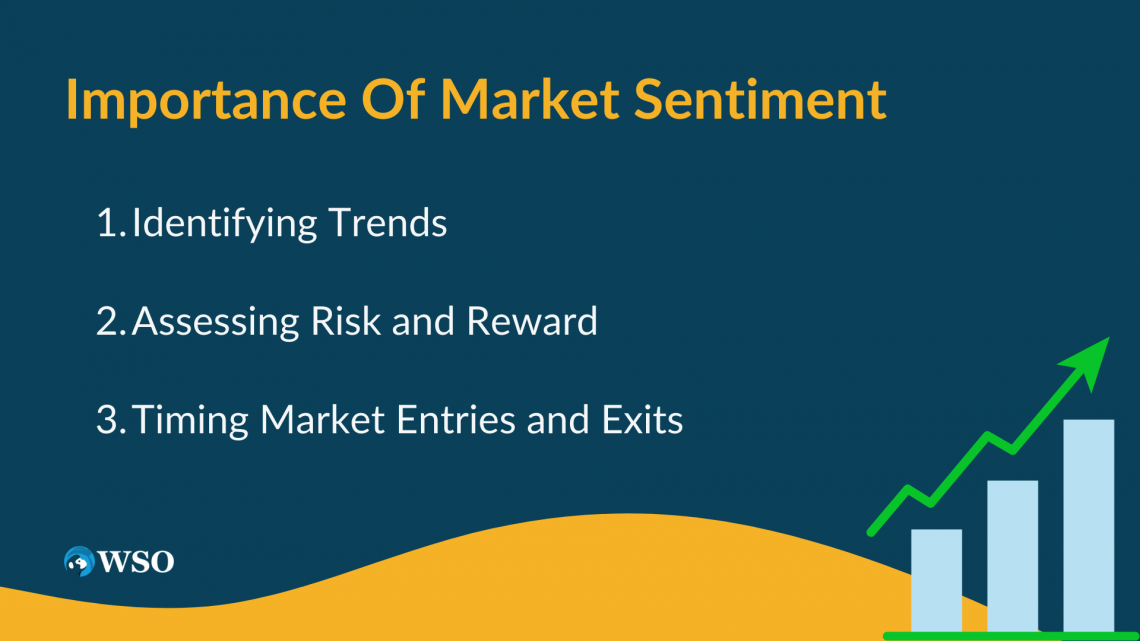
It is essential to trading and investing because it affects market participants' purchasing and selling choices.
1. Identifying Trends
Market sentiment helps traders and investors identify the prevailing trend in the market. Understanding the market sentiment can assist in aligning trading strategies with the prevailing trend, increasing the probability of successful trades.
2. Assessing Risk and Reward
Market sentiment provides insights into a particular investment's potential risk and reward. In bullish sentiment, there is typically more optimism and higher potential for gains. Conversely, bearish sentiment has more pessimism and a higher potential for losses.
Note
By assessing market sentiment, traders and investors can adjust their risk tolerance and position sizing accordingly.
3. Timing Market Entries and Exits
Market sentiment can help traders time their entries and exits in the market. For example, entering a long position when bullish sentiment is prevalent may offer better profit opportunities.
Examples Of TRIN Indicator
It is crucial to remember that the usefulness of any indicator can vary based on individual trading strategies and market conditions, even while specific case studies and examples can offer insightful information about the effective usage of the TRIN (Trading Index) indicator.
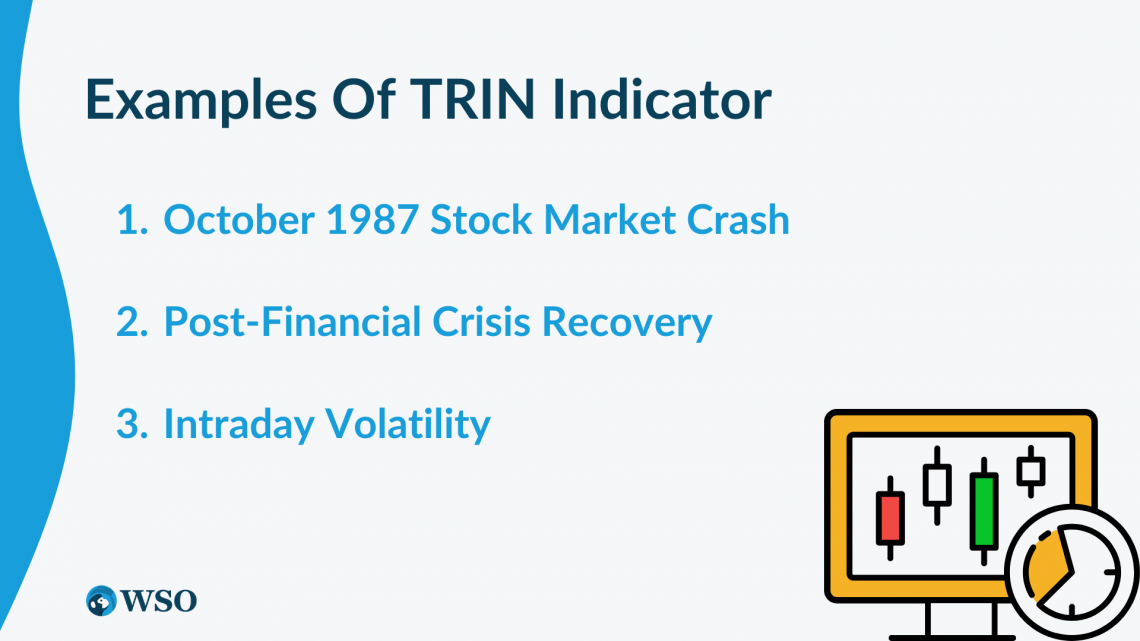
Here are a few brief examples that illustrate the potential use and success of the TRIN indicator:
1. October 1987 Stock Market Crash
The TRIN indicator gained attention during the 1987 stock market crash, also known as Black Monday. On October 19, 1987, the TRIN indicator reached extremely high levels, indicating intense selling pressure and oversold market conditions.
Traders who used it as a contrarian signal to identify potential market bottoms were able to capitalize on the subsequent rebound.
2. Post-Financial Crisis Recovery
Following the 2008 financial crisis, the TRIN indicator played a role in identifying market bottoms and signaling potential trend reversals.
Note
As markets reached oversold conditions, the TRIN indicator provided early indications of improving sentiment and helped traders identify opportunities for entering long positions.
3. Intraday Volatility
The TRIN indicator has proven useful in managing intraday volatility. Traders often monitor TRIN readings during volatile periods to assess market sentiment and potential trend shifts.
Extreme readings, especially during the first hour of trading, can guide traders in making decisions, such as entering or exiting positions.
TRIN Indicator And Market Sentiment
The TRIN Indicator can be used as a tool to gauge market sentiment by analyzing the relationship between advancing and declining stocks and their corresponding trading volumes. Here's how it can help in assessing market sentiment:
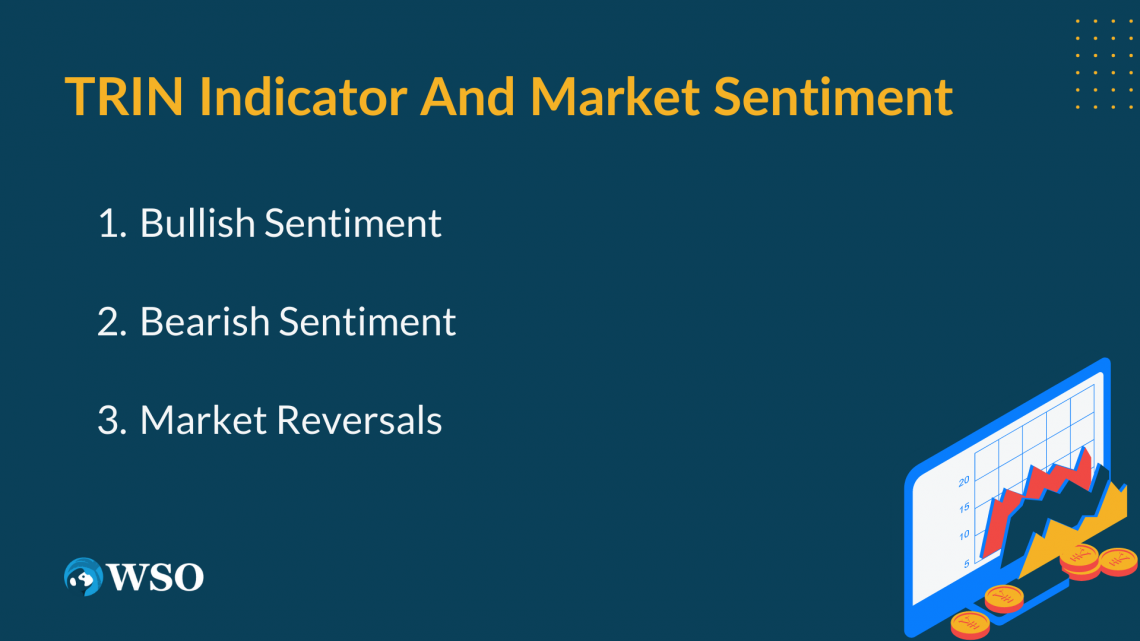
1. Bullish Sentiment
In a bullish market sentiment, there are typically more advancing stocks than declining stocks. This results in a TRIN value below 1.
Additionally, the volume of advancing stocks is usually higher than the volume of declining stocks, further supporting the bullish sentiment. Traders can use a low TRIN value to confirm a bullish sentiment and potentially identify buying opportunities.
2. Bearish Sentiment
In a bearish market sentiment, there tends to be a higher number of declining stocks than advancing stocks. This results in a TRIN value above 1.
Note
The volume of declining stocks is usually higher than the volume of advancing stocks, reinforcing the bearish sentiment.
3. Market Reversals
Changes in market sentiment can often precede market reversals. Traders can observe divergences between the TRIN Indicator and price movements to anticipate potential shifts in sentiment.
For example, if the market is making new highs while the TRIN is showing a bearish divergence (higher TRIN values), it could indicate a potential change in sentiment and a possible trend reversal.
Note
TRIN Indicator is just one tool among many used to gauge market sentiment. Traders and investors should consider using it in conjunction with other technical indicators and fundamental analysis to obtain a comprehensive understanding of market sentiment and make informed trading decisions.
Role In Identifying Market Conditions
Traders and investors use the Trin Indicator to anticipate potential market reversals or confirm the strength of a trend. It can help identify periods of market exhaustion or divergence, which can be valuable for making informed trading decisions.

Some of the examples wherein it has been used are:
1. October 1987 Market Crash
The TRIN Indicator gained prominence during the stock market crash of October 1987, also known as "Black Monday." Before the crash, the TRIN Indicator showed persistently high readings, indicating intense selling pressure and bearish market sentiment.
Traders who paid attention to the TRIN values were able to identify the increasing risk in the market and potentially exit their positions or take short positions, avoiding significant losses during the crash.
2. March 2009 Bottom
During the 2008 financial crisis, the TRIN Indicator played a role in identifying a potential bottom in the market. In March 2009, as the market approached its lows, it reached extremely high values, indicating excessive selling and extreme bearish sentiment.
Note
Traders who recognized this oversold condition and used the TRIN Indicator as a contrarian signal were able to identify a potential turning point in the market and position themselves for the subsequent bullish rally.
3. August 2015 Flash Crash
In August 2015, global markets experienced a sudden and severe downturn, often called a "flash crash." Prior to the crash, the TRIN Indicator showed a significant increase in its readings, suggesting a surge in selling pressure and bearish market sentiment.
Traders who monitored the TRIN values were able to recognize the deteriorating market conditions and potentially take protective measures such as exiting long positions or implementing hedging strategies.
4. Intraday Reversals
The TRIN Indicator can also be valuable for identifying intraday reversals and short-term trading opportunities. Traders may observe situations where the market opens with a low TRIN value, indicating positive sentiment.
However, as the trading day progresses, if the TRIN value starts rising and reaches high levels (above 1), it may suggest a shift toward bearish sentiment and potentially provide a signal for short-term traders to consider shorting opportunities or exiting long positions.
Note
It's important to note that while the examples highlight the potential usefulness of the TRIN Indicator, they should be used in conjunction with other technical analysis tools, indicators, and market observations for a more comprehensive analysis.
Tips for Utilizing TRIN Indicator
Incorporating the TRIN (Trading Index) indicator into trading strategies requires careful consideration and best practices. Here are practical tips for effectively utilizing the TRIN indicator:
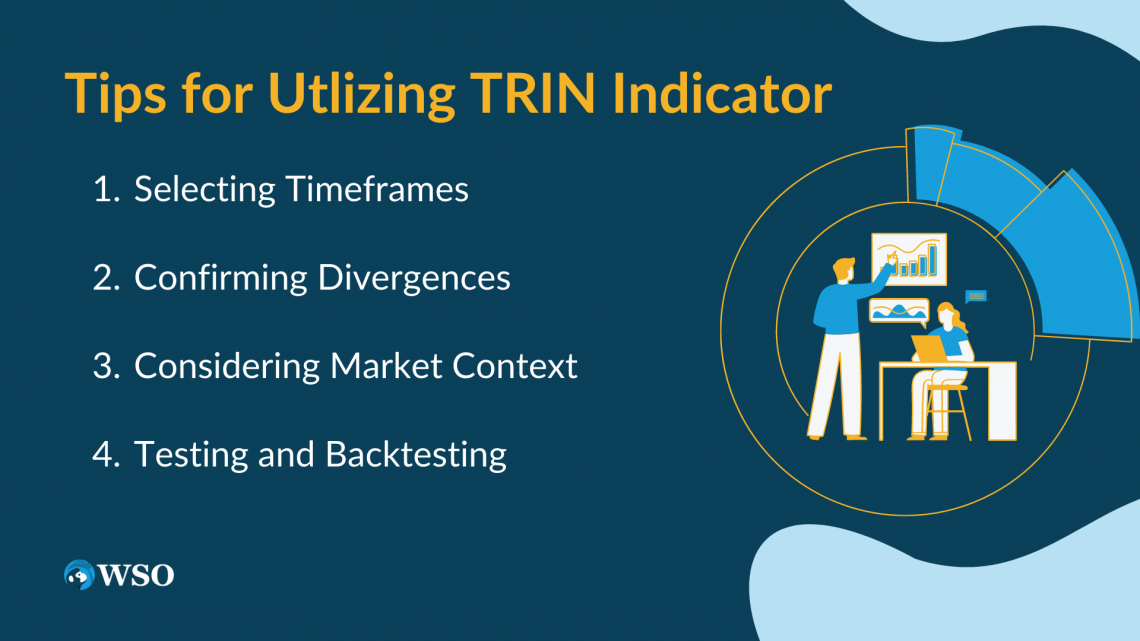
1. Selecting Timeframes
Choose appropriate timeframes that align with your trading strategy. Shorter timeframes, like intraday charts, can provide insights into intraday market sentiment and potential reversals. Longer timeframes, such as daily or weekly charts, can help identify broader market trends and reversals.
2. Confirming Divergences
Pay attention to divergences between the TRIN indicator and price movement. When the TRIN indicator shows a different direction or pattern than the price, it may suggest a potential market reversal or change in sentiment. Confirm such divergences with other technical indicators for stronger signals.
3. Considering Market Context
Interpret TRIN readings within the context of the broader market environment. Factors such as prevailing trends, volatility levels, economic events, and news announcements can influence the significance of TRIN values.
Note
Consider these contextual factors when interpreting and acting on TRIN signals.
4. Testing and Backtesting
Conduct thorough testing and backtesting before integrating the TRIN indicator into live trading. Validate its effectiveness and understand its limitations through historical data analysis and simulated trading scenarios. This process will help fine-tune its parameters and optimize its use within your trading strategy.




or Want to Sign up with your social account?